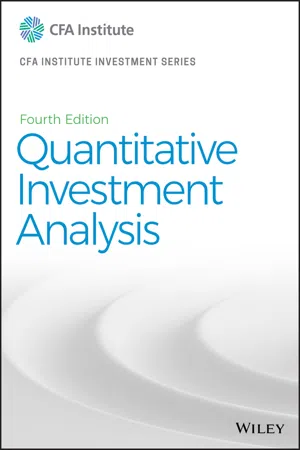
- English
- ePUB (mobile friendly)
- Available on iOS & Android
About this book
Whether you are a novice investor or an experienced practitioner, Quantitative Investment Analysis, 4th Edition has something for you.
Part of the CFA Institute Investment Series, this authoritative guide is relevant the world over and will facilitate your mastery of quantitative methods and their application in todays investment process. This updated edition provides all the statistical tools and latest information you need to be a confident and knowledgeable investor. This edition expands coverage of Machine Learning algorithms and the role of Big Data in an investment context along with capstone chapters in applying these techniques to factor modeling, risk management and backtesting and simulation in investment strategies.
The authors go to great lengths to ensure an even treatment of subject matter, consistency of mathematical notation, and continuity of topic coverage that is critical to the learning process. Well suited for motivated individuals who learn on their own, as well as a general reference, this complete resource delivers clear, example-driven coverage of a wide range of quantitative methods. Inside you'll find:
- Learning outcome statements (LOS) specifying the objective of each chapter
- A diverse variety of investment-oriented examples both aligned with the LOS and reflecting the realities of todays investment world
- A wealth of practice problems, charts, tables, and graphs to clarify and reinforce the concepts and tools of quantitative investment management
You can choose to sharpen your skills by furthering your hands-on experience in the Quantitative Investment Analysis Workbook, 4th Edition (sold separately)—an essential guide containing learning outcomes and summary overview sections, along with challenging problems and solutions.
Frequently asked questions
- Essential is ideal for learners and professionals who enjoy exploring a wide range of subjects. Access the Essential Library with 800,000+ trusted titles and best-sellers across business, personal growth, and the humanities. Includes unlimited reading time and Standard Read Aloud voice.
- Complete: Perfect for advanced learners and researchers needing full, unrestricted access. Unlock 1.4M+ books across hundreds of subjects, including academic and specialized titles. The Complete Plan also includes advanced features like Premium Read Aloud and Research Assistant.
Please note we cannot support devices running on iOS 13 and Android 7 or earlier. Learn more about using the app.
Information
CHAPTER 1
THE TIME VALUE OF MONEY
LEARNING OUTCOMES
- interpret interest rates as required rates of return, discount rates, or opportunity costs;
- explain an interest rate as the sum of a real risk-free rate and premiums that compensate investors for bearing distinct types of risk;
- calculate and interpret the effective annual rate, given the stated annual interest rate and the frequency of compounding;
- solve time value of money problems for different frequencies of compounding;
- calculate and interpret the future value (FV) and present value (PV) of a single sum of money, an ordinary annuity, an annuity due, a perpetuity (PV only), and a series of unequal cash flows;
- demonstrate the use of a time line in modeling and solving time value of money problems.
1. INTRODUCTION
2. INTEREST RATES: INTERPRETATION
Table of contents
- Cover
- Title Page
- Copyright
- CONTENTS
- PREFACE
- ACKNOWLEDGMENTS
- ABOUT THE CFA INSTITUTE INVESTMENT SERIES
- CHAPTER 1: THE TIME VALUE OF MONEY
- CHAPTER 2: ORGANIZING, VISUALIZING, AND DESCRIBING DATA
- CHAPTER 3: PROBABILITY CONCEPTS
- CHAPTER 4: COMMON PROBABILITY DISTRIBUTIONS
- CHAPTER 5: SAMPLING AND ESTIMATION
- CHAPTER 6: HYPOTHESIS TESTING
- CHAPTER 7: INTRODUCTION TO LINEAR REGRESSION
- CHAPTER 8: MULTIPLE REGRESSION
- CHAPTER 9: TIME-SERIES ANALYSIS
- CHAPTER 10: MACHINE LEARNING
- CHAPTER 11: BIG DATA PROJECTS
- CHAPTER 12: USING MULTIFACTOR MODELS
- CHAPTER 13: MEASURING AND MANAGING MARKET RISK
- CHAPTER 14: BACKTESTING AND SIMULATION
- APPENDICES
- GLOSSARY
- ABOUT THE AUTHORS
- ABOUT THE CFA PROGRAM
- INDEX
- END USER LICENSE AGREEMENT